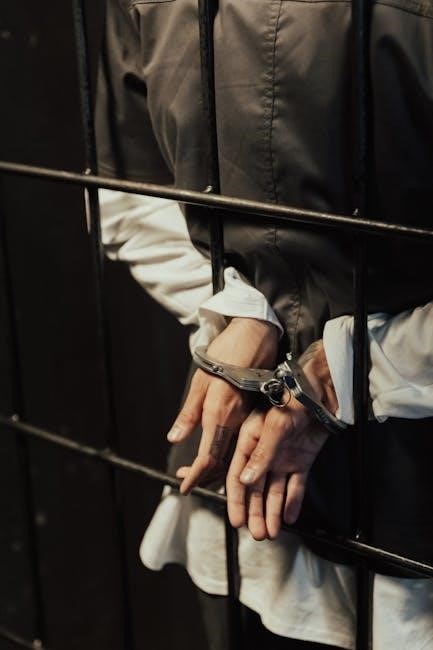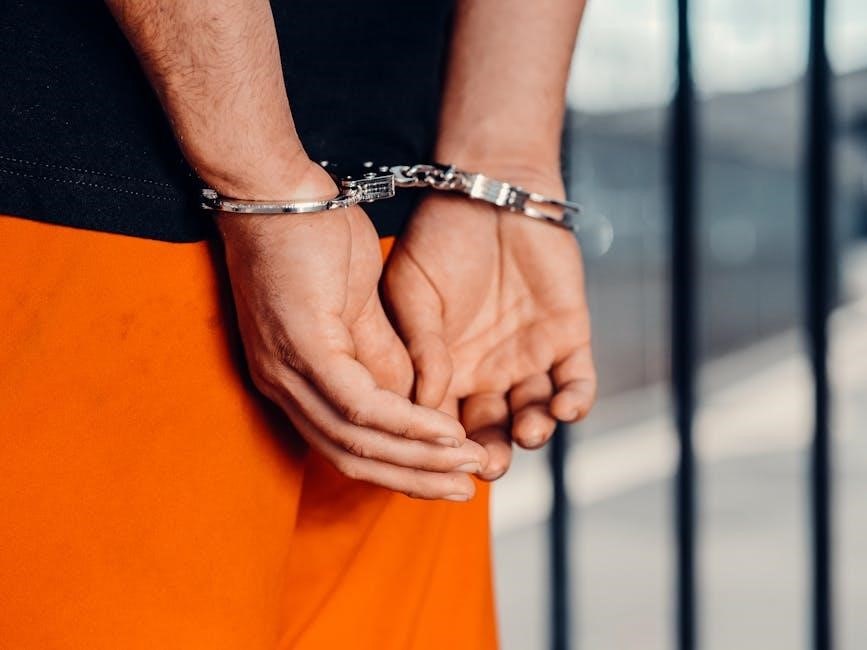Irving Jail serves as a key correctional facility‚ ensuring public safety and order. This guide provides comprehensive insights into its operations‚ inmate life‚ and legal framework.
1.1 Overview of Irving Jail
The Irving Jail is a correctional facility located in Irving‚ Texas‚ serving as a temporary holding center for individuals awaiting trial or serving short sentences. Operated by the Irving Police Department‚ it plays a critical role in maintaining law and order within the community. The facility is designed to ensure the safety and security of both inmates and staff‚ adhering to strict protocols and regulations. Irving Jail focuses on providing humane treatment‚ basic amenities‚ and essential services to detainees. It also offers programs aimed at rehabilitation and preparation for reintegration into society. Understanding its structure and operations is essential for grasping its role in the criminal justice system.
1.2 Purpose of the Irving Jail PDF
The Irving Jail PDF serves as a comprehensive resource‚ providing detailed insights into the facility’s operations‚ policies‚ and procedures. Its primary purpose is to educate the public‚ inmates‚ and stakeholders about the jail’s functions‚ inmate rights‚ and available services. The document aims to promote transparency and accountability by outlining the legal framework‚ daily routines‚ and rehabilitation programs. It also serves as a guide for individuals seeking information about visitation rules‚ bail procedures‚ and communication policies. By offering a clear understanding of the jail’s structure and ethical practices‚ the PDF fosters trust and cooperation between the facility and the community it serves.
1;3 Importance of Understanding Jail Operations
Understanding Irving Jail’s operations is crucial for ensuring transparency and accountability within the correctional system. It fosters public trust and provides insight into how the facility manages inmates‚ ensuring their rights are upheld. This knowledge supports the safety and well-being of both inmates and staff‚ promoting a fair and rehabilitative environment. By comprehending jail operations‚ the community can better appreciate the challenges faced by correctional facilities and the measures taken to rehabilitate offenders. This understanding also aids in evaluating the effectiveness of rehabilitation programs‚ which are essential for reducing recidivism and promoting community safety. Ultimately‚ informed awareness contributes to a more just‚ efficient‚ and fair criminal justice system.

History of Irving Jail
Irving Jail was established to address the city’s growing need for a secure correctional facility‚ playing a vital role in upholding law and order since its founding.
2.1 Background and Establishment
The Irving Jail was established in the mid-20th century to address the growing need for a local law enforcement facility in Irving‚ Texas. Constructed in 1950‚ the jail was designed to serve as a temporary holding facility for individuals awaiting trial or serving short sentences. Its creation was a response to the increasing population and the need for a structured criminal justice system in the area. The jail’s initial design included basic amenities to meet the essential needs of inmates and staff. With an initial capacity of 50 inmates‚ it played a crucial role in maintaining public safety and order in the community. Since its inception‚ the Irving Jail has been a cornerstone of local law enforcement‚ symbolizing justice and stability for the city of Irving.
2.2 Evolution Over the Years
Since its establishment‚ the Irving Jail has undergone significant transformations to meet the evolving needs of law enforcement and the community. In the 1980s‚ the facility was expanded to accommodate a growing inmate population‚ with additional cells and improved security measures. The 2000s saw the introduction of modern technology‚ including advanced surveillance systems and electronic record-keeping. The jail has also adapted its policies to prioritize inmate rehabilitation‚ offering educational programs and counseling services. These changes reflect a shift toward a more humane and efficient correctional system. Today‚ the Irving Jail continues to modernize‚ ensuring it remains a vital component of Irving’s public safety infrastructure.
2.3 Notable Events in Irving Jail’s History
Irving Jail has witnessed several significant events that have shaped its history. In 1995‚ a major riot occurred‚ prompting a review of security protocols. In 2003‚ the facility underwent a $12 million expansion to address overcrowding. A notable escape attempt in 2010 led to enhanced surveillance measures. The jail achieved national accreditation in 2015 for meeting high correctional standards. Additionally‚ in 2020‚ it implemented a new digital booking system to streamline operations. These events highlight the jail’s commitment to safety‚ efficiency‚ and accountability‚ ensuring it remains a cornerstone of Irving’s law enforcement and correctional efforts.

Structure and Facilities
Irving Jail features a modern design with secure‚ durable materials. The facility includes housing units‚ administrative offices‚ medical areas‚ and recreational spaces‚ ensuring functionality and safety.
3.1 Architecture and Design
Irving Jail’s architecture is designed for security‚ functionality‚ and inmate rehabilitation. The facility features modern‚ durable materials and a layout that maximizes surveillance and operational efficiency. The design incorporates reinforced walls‚ secure entry points‚ and strategic placement of observation towers to ensure safety. Natural light and ventilation are integrated to create a calm environment‚ while the segregation of different housing units prevents conflicts. The design adheres to national correctional standards‚ balancing aesthetics with practicality to support both custody and rehabilitative goals effectively.
3.2 Available Amenities and Services
Irving Jail provides essential amenities to ensure inmate well-being and rehabilitation. These include nutritious meals‚ medical care‚ and hygiene facilities. Educational programs‚ counseling‚ and recreational activities are offered to promote personal growth. Inmates also have access to libraries‚ religious services‚ and visitation areas. The facility ensures access to legal resources and mail services. These amenities aim to support rehabilitation while maintaining a secure environment. The jail also offers substance abuse treatment and mental health services to address specific needs. Such programs and services are designed to prepare inmates for reintintegration into society upon release.
3.3 Capacity and Population Management
Irving Jail is designed to accommodate a specific inmate population‚ ensuring efficient management of space and resources. The facility operates with a structured classification system to house inmates based on their risk levels and needs. To manage overcrowding‚ the jail implements strategies such as alternative sentencing programs and transfers to other facilities when necessary. Population management also involves regular monitoring and adjustments to maintain order and safety. The jail’s capacity is carefully balanced with the detainee intake to prevent overpopulation. Additionally‚ the administration continuously reviews and updates protocols to ensure optimal use of available space and resources‚ aligning with legal and safety standards.

Inmate Life and Programs
Irving Jail focuses on structured routines‚ rehabilitation‚ and wellness to support inmates. Programs include education‚ counseling‚ and health services‚ aiming to prepare individuals for reintintegration into society.
4.1 Daily Routine and Schedules
Inmates at Irving Jail follow a structured daily routine to maintain order and productivity. The day typically begins with an early morning wake-up call‚ followed by breakfast. Meals are served at designated times‚ with lunch at noon and dinner in the evening. Roll calls are conducted regularly to ensure accountability. Time is allocated for educational programs‚ counseling sessions‚ and recreational activities. Inmates also have access to library resources and religious services. Security patrols and surveillance are continuous to ensure safety. The routine is designed to balance structure with opportunities for personal growth‚ preparing inmates for eventual reintegration into society.
4.2 Rehabilitation and Educational Programs
Irving Jail offers a variety of rehabilitation and educational programs to support inmate reform. These include GED preparation‚ vocational training‚ and life skills workshops. Counseling sessions address substance abuse and mental health challenges‚ promoting personal growth. Educational programs aim to enhance literacy and employability‚ reducing recidivism rates. Additionally‚ inmates can participate in religious and spiritual guidance‚ fostering emotional well-being. These initiatives provide inmates with tools to rebuild their lives‚ encouraging positive change and successful reintegration into society upon release. The focus is on empowering individuals to overcome past mistakes and achieve a productive future.
4.3 Health and Wellness Initiatives
Irving Jail prioritizes inmate health and wellness through comprehensive programs. Medical services include routine check-ups‚ mental health evaluations‚ and treatment for chronic conditions. Fitness programs and recreational activities promote physical well-being. Additionally‚ nutritional meals and hygiene facilities are provided to maintain health standards. Mental health support is available to address stress‚ anxiety‚ and other emotional challenges. These initiatives aim to create a balanced environment that supports inmates’ overall wellness during their stay. By addressing both physical and mental health needs‚ Irving Jail strives to ensure inmates’ well-being and prepare them for a healthier life upon release. These efforts reflect a commitment to humane treatment and rehabilitation.

Security and Safety Measures
Irving Jail employs advanced physical security systems‚ including cameras and alarms‚ alongside strict access controls. Trained personnel ensure a safe environment‚ preventing incidents and maintaining order.
5.1 Physical Security Systems
Irving Jail features robust physical security systems to ensure inmate and staff safety. These include reinforced walls‚ secure fencing‚ and electronic gates. Access points are equipped with biometric scanners and metal detectors. Surveillance cameras are strategically placed throughout the facility‚ with monitoring stations for real-time oversight. Alarms and motion detectors are installed to respond swiftly to unauthorized movements. Additionally‚ the jail employs advanced locking mechanisms and segregated housing units to maintain order. These systems collectively form a multi-layered security framework designed to prevent breaches and uphold operational integrity‚ ensuring a controlled environment for both inmates and personnel.
5.2 Surveillance and Monitoring
Irving Jail employs advanced surveillance and monitoring systems to maintain continuous oversight of inmate activities. High-definition cameras are strategically positioned throughout the facility‚ including dormitories‚ common areas‚ and perimeter zones. Digital monitoring systems enable real-time tracking of movements and behaviors. Security personnel oversee these systems from central monitoring stations‚ ensuring immediate response to potential threats. Additionally‚ automated alerts notify staff of unusual activity‚ enhancing incident prevention. This comprehensive surveillance framework supports the jail’s mission to uphold safety‚ deter misconduct‚ and protect both inmates and staff. Regular system checks and updates ensure optimal functionality and adherence to modern security standards.
5.3 Emergency Response Protocols
Irving Jail has established robust emergency response protocols to address critical situations effectively. These protocols include detailed procedures for fires‚ medical emergencies‚ inmate disturbances‚ and natural disasters. Trained staff conduct regular drills to ensure readiness. Communication systems are designed for rapid alert dissemination‚ enabling swift action. Coordination with local emergency services ensures external support when needed. The protocols prioritize inmate and staff safety‚ minimizing risks during crises. Continuous reviews and updates keep the strategies aligned with best practices‚ ensuring preparedness for unforeseen events. These measures underscore the jail’s commitment to maintaining order and security under all circumstances.

Legal and Ethical Considerations
Irving Jail operates under strict legal obligations and ethical standards‚ ensuring inmate rights are protected while maintaining accountability in its management and operations.
6.1 Rights of Inmates
Inmate rights at Irving Jail are protected under federal and state laws‚ ensuring access to legal counsel‚ medical care‚ and humane treatment. The facility adheres to constitutional standards‚ prohibiting discrimination based on race‚ gender‚ or religion. Inmates are entitled to privacy‚ correspondence‚ and visitation rights‚ subject to security protocols. The jail also ensures access to educational and recreational programs‚ promoting mental and physical well-being. Regular audits and oversight mechanisms are in place to monitor compliance with these rights‚ safeguarding against abuse or neglect. These measures aim to uphold dignity and justice within the correctional system‚ aligning with ethical and legal obligations.
6.2 Ethical Practices in Jail Management
Ethical practices are cornerstone to Irving Jail’s operations‚ ensuring fairness‚ transparency‚ and respect for human rights. Staff undergo rigorous training to maintain professionalism and avoid misconduct. The facility emphasizes accountability‚ with clear protocols for addressing grievances and use of force. Confidentiality is upheld in handling medical and personal records‚ safeguarding inmate privacy. Ethical guidelines also ensure equitable treatment‚ regardless of an inmate’s background. Regular audits and performance reviews help maintain high standards‚ fostering trust between the jail and the community. These practices aim to promote a safe‚ just‚ and rehabilitative environment‚ aligning with broader societal values and legal requirements.

6.3 Legal Compliance and Accountability
Irving Jail prioritizes legal compliance and accountability to ensure operations align with federal‚ state‚ and local laws. Regular audits and inspections are conducted to verify adherence to correctional standards. The facility maintains transparency by documenting all procedures‚ including inmate intake‚ disciplinary actions‚ and medical care. Staff are trained to uphold legal protocols‚ and any violations are promptly addressed through internal investigations and disciplinary measures. Public reports and open records requests ensure accountability to the community. Irving Jail also collaborates with oversight agencies to maintain trust and integrity. By adhering to legal frameworks‚ the facility strives to protect inmates’ rights while ensuring public safety and justice.

Community Relations and Engagement
Irving Jail fosters strong community ties through transparency‚ public outreach‚ and collaborative efforts‚ ensuring trust and cooperation while maintaining public safety and justice.
7.1 Public Perception of Irving Jail
Public perception of Irving Jail varies‚ with some viewing it as a necessary institution for maintaining order‚ while others raise concerns about conditions and inmate treatment. Transparency and accountability efforts have improved its image in recent years. Community engagement initiatives and educational programs aim to foster trust and understanding. However‚ occasional controversies and allegations of misconduct continue to impact public opinion. The jail’s administration works to address these issues through open communication and reforms. Overall‚ perceptions are shaped by a mix of awareness‚ personal experiences‚ and media coverage‚ highlighting the need for ongoing dialogue and improvement to ensure a positive community relationship.
7.2 Community Outreach Programs
Irving Jail actively engages with the community through outreach programs aimed at fostering trust and understanding. These initiatives include educational workshops‚ mentorship programs‚ and partnerships with local organizations. The jail offers resources to help inmates’ families navigate the judicial system and provides support for reintegration into society. Regular events‚ such as job fairs and health clinics‚ are organized to benefit both inmates and the broader community. These efforts highlight the jail’s commitment to rehabilitation and public safety. By involving residents in these programs‚ Irving Jail strives to create a positive dialogue and strengthen its role as a responsible community partner. Volunteer opportunities further encourage active participation and collaboration.
7.3 Collaboration with Local Law Enforcement
Irving Jail collaborates closely with local law enforcement agencies to ensure effective crime prevention and public safety. This partnership involves shared intelligence‚ coordinated operations‚ and joint efforts to address criminal activities. Regular communication and strategic planning enable seamless cooperation‚ enhancing the efficiency of law enforcement initiatives. The jail also participates in training sessions and technology-sharing programs to strengthen its collaboration. By working together‚ Irving Jail and local law enforcement aim to reduce crime rates and improve community safety. This collaborative approach not only aids in managing inmate populations but also supports broader public security goals. Such partnerships underscore the importance of unity in maintaining law and order.

Challenges and Controversies
Irving Jail faces challenges like overcrowding‚ resource constraints‚ and misconduct allegations‚ which spark controversies. Budget limitations further complicate inmate care and facility upgrades‚ raising concerns about safety and conditions;
8.1 Overcrowding and Resource Management
Overcrowding at Irving Jail stems from rising arrest rates and limited facility capacity‚ leading to strained resources and increased stress on both inmates and staff. This issue exacerbates tensions‚ complicates daily operations‚ and raises concerns about inmate welfare. Managing resources effectively becomes challenging‚ as overcrowding often results in inadequate access to essential services like healthcare and rehabilitation programs. Authorities have implemented measures such as alternative sentencing and bail reforms to alleviate overcrowding‚ but these efforts face resistance and funding constraints. Balancing resource allocation with inmate needs remains a critical challenge‚ requiring innovative solutions to ensure humane and efficient facility management.
8.2 Allegations of Misconduct
Irving Jail has faced allegations of misconduct‚ including claims of improper treatment of inmates and unprofessional behavior by staff. These incidents have raised public concern and sparked investigations. While some cases have been substantiated‚ others remain under review. Transparency in addressing such issues is crucial to maintaining public trust. The facility has implemented stricter oversight and training programs to prevent future misconduct. However‚ recurring allegations highlight the need for ongoing vigilance and accountability. Addressing these concerns is essential to ensure a safe and just environment for both inmates and staff‚ upholding the facility’s mission to rehabilitate and protect the community.
8.3 Budgetary Constraints and Funding Issues
Irving Jail faces budgetary constraints that impact its ability to provide adequate resources and services. Limited funding hinders facility maintenance‚ staff training‚ and program implementation. Overcrowding exacerbates these challenges‚ straining existing infrastructure. Efforts to secure additional funding are ongoing‚ but budgetary limitations remain a significant hurdle. The jail must prioritize spending to ensure essential operations‚ often at the expense of rehabilitative programs. Financial constraints also affect inmate care and safety‚ raising concerns about long-term sustainability. Addressing these funding issues is critical to improving conditions and ensuring the facility meets its goals effectively.

Future Directions and Reforms
Irving Jail aims to modernize facilities and enhance inmate care through technological upgrades and expanded rehabilitation programs‚ ensuring safer and more efficient operations for the future.
9.1 Proposed Expansions and Upgrades
Plans for Irving Jail include expanding housing units to alleviate overcrowding and upgrading medical facilities to improve inmate care. Enhanced security systems‚ such as advanced surveillance and access control‚ are also proposed. These upgrades aim to modernize the facility‚ ensuring safer conditions for both inmates and staff. Additionally‚ there are discussions about integrating renewable energy sources to reduce operational costs and environmental impact. The proposed expansions also include dedicated spaces for rehabilitation programs‚ reflecting a commitment to inmate reform. These upgrades are expected to enhance the jail’s efficiency and align with contemporary correctional standards‚ fostering a more rehabilitative environment.
9.2 Modernization of Facilities
The modernization of Irving Jail focuses on improving infrastructure and inmate living conditions. Plans include updating outdated cells‚ enhancing lighting and ventilation systems‚ and installing energy-efficient equipment. Additionally‚ the facility aims to integrate advanced communication technologies to facilitate inmate-family interactions and improve administrative efficiency. Renovations also prioritize accessibility‚ ensuring compliance with disability standards. Modernizing the facilities will not only enhance safety and comfort but also support the overall goal of rehabilitation. These updates are designed to create a more humane and functional environment‚ aligning with contemporary correctional practices and promoting a positive transformation for both inmates and staff.
9.3 Implementation of New Technologies
The implementation of new technologies at Irving Jail aims to enhance security‚ improve efficiency‚ and support inmate rehabilitation. Advanced biometric systems‚ such as facial recognition and fingerprint scanning‚ will be introduced to strengthen identification processes. Digital platforms will be integrated to streamline inmate records‚ visitation scheduling‚ and communication with legal representatives. Additionally‚ automated surveillance systems will be installed to monitor facilities in real-time‚ reducing risks and ensuring safer environments. These technological advancements will also support educational and counseling programs by providing inmates with access to digital resources. By embracing modern technology‚ Irving Jail strives to create a more secure‚ efficient‚ and rehabilitative environment for both staff and inmates.
Irving Jail plays a vital role in maintaining public safety and rehabilitating inmates. Continuous improvements ensure a balanced approach to security‚ welfare‚ and community trust.
10.1 Summary of Key Points
10.2 Final Thoughts on Irving Jail’s Role
Irving Jail plays a pivotal role in maintaining public safety and order within the community. Beyond detention‚ it serves as a rehabilitative institution‚ aiming to prepare inmates for reintegration into society. The facility’s commitment to balancing security with support services underscores its dedication to ethical practices and inmate welfare. By addressing recidivism through education and counseling‚ Irving Jail contributes to long-term community well-being. While challenges persist‚ the jail remains a cornerstone of the criminal justice system‚ fostering trust through transparency and accountability. Its role extends beyond confinement‚ emphasizing rehabilitation and societal reintegration‚ making it an essential asset for both justice and community harmony.
10.3 Recommendations for Future Improvements
To enhance Irving Jail’s effectiveness‚ modernizing facilities and expanding rehabilitation programs is crucial. Investing in technology‚ such as automated systems for monitoring and case management‚ can improve efficiency and safety. Increasing staff training on ethical practices and de-escalation techniques will foster a more humane environment. Expanding educational and vocational programs can reduce recidivism rates by equipping inmates with skills for post-release success. Addressing overcrowding through alternative sentencing and community partnerships is essential. Strengthening transparency and public engagement will build trust and accountability. By prioritizing inmate welfare and community safety‚ Irving Jail can become a model for progressive correctional practices‚ ensuring a safer and more just society for all.



